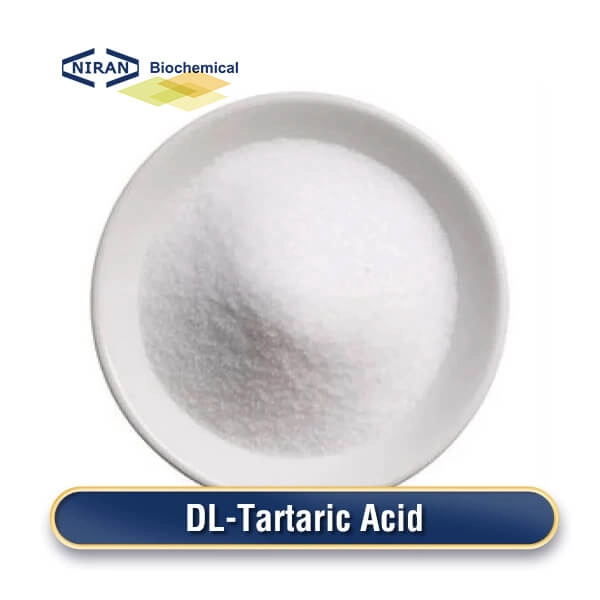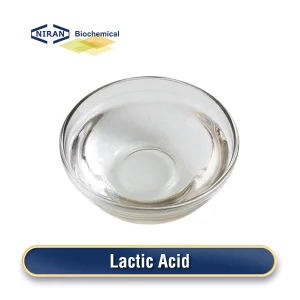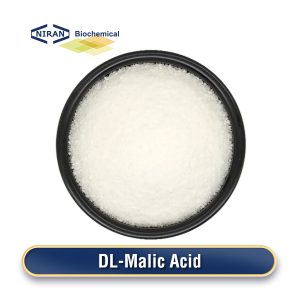Niran Biochemical
YOUR RELIABLE FOOD INGREDIENTS
Send Inquiry
Home » Products » Acidulants » DL-Tartaric Acid
DL-Tartaric Acid
- CAS: 133-37-9
- Chemical Formula: C4H6O6
- Certification: KOSHER, ISO, HALAL, FSSC22000, BRC, etc.
- Standard:
- MOQ: 1000KG
- Shelf Life: 2 Years
Inquire Product
Product Description
What is DL-Tartaric Acid?
DL-tartaric acid appears as white crystals or powder, with no irritating odor. DL-tartaric acid appears as white crystals or powder, has no pungent odor, is relatively stable in the air, and can be used as an acidulant in various foods. Its sourness is 1 times higher than that of citric acid.
The industrial production methods of tartaric acid mainly include extraction, chemical synthesis, semi-synthesis, and fermentation, among which the most popular one in China is chemical synthesis.
1. Extraction method
Tartaric acid was first extracted from the sediment at the bottom of the winemaking process. The main components of this substance are tartaric acid and potassium hydrogen salt. The tartar is crushed and dissolved, then reacted with calcium hydroxide, and then calcium chloride is added to convert it into calcium salt. Acidification with a slight excess of sulfuric acid obtains free tartaric acid, which is then concentrated, refined, and dried to obtain solid tartaric acid.
2. Chemical synthesis method
(1)Oxidation of benzene or naphthalene to obtain maleic acid and fumaric acid, and then adding hydrogen peroxide to react to obtain DL-tartaric acid.
(2)Maleic anhydride can also be used as a raw material, hydrogen peroxide as an oxidant, and tungstic acid as a catalyst to generate epoxy succinic acid, which is finally hydrolyzed to obtain tartaric acid, and then the tartaric acid product is finally obtained through cooling, crystallization, separation, drying and other process means.
3. Semi-synthetic method
Maleic acid is first epoxidized to generate cis-epoxy succinic acid and its salts, and then epoxy succinic acid hydrolase is used to hydrolyze it to obtain tartaric acid.
Another method is to use disodium cis-epoxysuccinate as a precursor and finally obtain tartaric acid through fermentation.
At present, the bioconversion rate of tartaric acid obtained by laboratory fermentation with cis-epoxysuccinic acid disodium as a substrate is 100%. The semi-synthetic method can not only improve the conversion rate but also extract products with high purity and good safety.
4. Fermentation method
The fermentation method uses microbial cells to convert carbon-containing compounds such as glucose and its derivatives, organic acids, etc. into tartaric acid.
Generally speaking, the investment in production by fermentation is relatively small, and the cost is only a fraction of the chemical synthesis method. It is easy to operate, has a wide source of raw materials, and does not have the pollution problems caused by chemical methods.
Related parameters:
| TITLE OF INDEX | INDEX | RESULT | |
| Sensory requirements | Colour | White | White |
| Shape | Particles or powder | Particles | |
| Assay (Based on C4H6O6 dry basis) % | ≥99.5 | 99.8 | |
| Melting point: ℃ | 200-206 | 203.2-204.1 | |
| Loss on drying: % | ≤0.5 | 0.02 | |
| Residue on ignition: % | ≤0.1 | 0.04 | |
| Sulfate test: % | ≤0.04 | <0.04 | |
| Readily oxidizable substances: | Pass test | Pass test | |
| Heavy metals [Pb]: mg/kg | ≤10.0 | <10.0 | |
| Arsenic [as As]: mg/kg | ≤2.0 | <2.0 | |
| Conclusion: | Qualified | ||
Recommended dosage:
| Food name | Maximum usage (g/kg) | Annotation |
| Candy | 18 | dl-tartaric acid only, calculated as tartaric acid |
| Solid compound seasoning | 10 | Calculated as tartaric acid |
| Chicken bouillon, chicken powder | 10 | Calculated as tartaric acid |
| Fruit and vegetable juice (pulp) drinks | 5 | Calculated as tartaric acid, the amount of solid beverages to be used shall be increased according to the dilution multiple |
| Plant protein drinks | 5 | Calculated as tartaric acid, the amount of solid beverages to be used shall be increased according to the dilution multiple |
| Compound protein drink | 5 | Calculated as tartaric acid, the amount of solid beverages to be used shall be increased according to the dilution multiple |
| Carbonated drinks | 5 | Calculated as tartaric acid, the amount of solid beverages to be used shall be increased according to the dilution multiple |
| Fried noodle products | 10 | Calculated as tartaric acid |
| Tea, coffee, plant (type) beverages | 5 | Calculated as tartaric acid, the amount of solid beverages to be used shall be increased according to the dilution multiple |
| Flavored drinks | 5 | Calculated as tartaric acid, the amount of solid beverages to be used shall be increased according to the dilution multiple |
| Wine | 4.0g/L | Calculated as tartaric acid |
DL-Tartaric Acid has a wide range of uses
1. Food industry
As an acidulant and stabilizer, it is often used in baked foods such as cakes and bread to help control the acidity and stability of food.
2. Pharmaceutical industry
In the pharmaceutical process, DL-tartaric acid can be used as a catalyst or neutralizing agent in the reaction to adjust the pH value of the drug and the chemical reaction process.
3. Other industrial applications:
For example, in the textile and leather industries, it is used as a chemical for pickling and adjusting pH.
User asked question:
Q: What is the difference between DL-Tartaric acid and L-Tartaric acid?
A: From the production process point of view, DL-Tartaric acid is a mixture obtained by chemical synthesis, containing equal amounts of left-handed (L-) and right-handed (D-) tartaric acid molecules; L-Tartaric acid is a pure left-handed isomer that exists naturally or is obtained by a specific synthesis method.
In terms of application, DL-Tartaric acid is usually more common in the manufacture of food additives and pharmaceutical intermediates because it contains two isomers. L-Tartaric acid is mainly used in fields that require specific optical activity, such as chemical synthesis and biological research.



